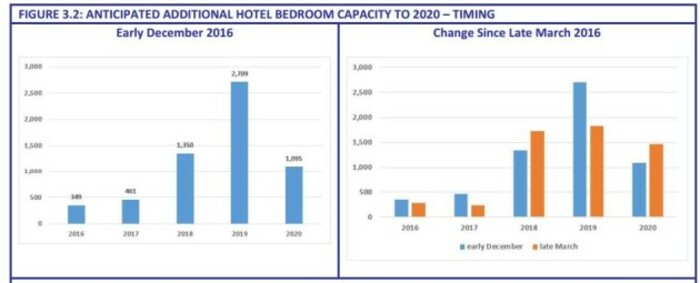Dublin's hotel crunch has created a 'double downside' for tourism
That’s according to a new report from Fáilte Ireland.
THE SHORTAGE OF available hotel rooms in Dublin has stifled growth in the capital’s tourism sector, according to a new study commissioned by Fáilte Ireland.
A high level of ‘compression’ – the number of nights where city centre hotels are more than 90% full – has created a “double downside” for the hospitality sector in Dublin.
Not only do visitors have trouble finding suitable accommodation on preferred nights, but higher room rates have led to “the overall perception of Dublin as an expensive destination”, the report said.
On average, hotels in the city centre and near Dublin Airport were 90% full on Tuesday, Wednesday, Thursday and Saturday nights from January to September of last year.
As a result, the average room rate for hotels in those prime locations on peak nights increased nearly 40% in three years to €140.
The report, which was compiled by consultancy firm Fitzpatrick Associates, said that as of December 2016, Dublin had the highest hotel occupancy rate in Europe. It saw the third-highest increase in average room rates after Kiev and St Petersburg.
However, even though the average price for a night in a Dublin hotel is in the “middle- to upper-end” of the scale, it is still well below the average rate for major cities like Paris, Zurich and London.
More rooms
The Fáilte Ireland report published this week was a follow-up on a similar study from March of last year.
The outcome of both studies was similar – that the bulk of extra hotel beds won’t be available until 2019 and there will be a capacity issue until then.

Click here to view a larger version.
However, the new report said there was a noticeable increase in the number of hotel development projects in the construction phase.
As a result, the estimated number of additional bedrooms in the pipeline until 2020 has increased by more than 400 to just over 5,960 extra rooms.
The report contributed this increase to a number of factors, including Fáilte Ireland’s revised regulation for average room sizes.
Last year, the state agency reduced the minimum size for a double room in a hotel from just under 18 m sq to 14 m sq. That new rule came into force in August 2016.
The report said it was too early to fully assess the impact of this change, but noted that it was “already having an effect on investment decisions”.
“We are aware of one operator whose decision to build a hotel rather than student accommodation was heavily influenced by contracting with a major brand that specialises in rooms that are smaller than the old minimum size.”
Sign up to our newsletter to receive a regular digest of Fora’s top articles delivered to your inbox.






